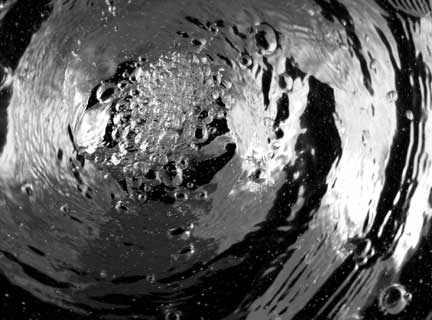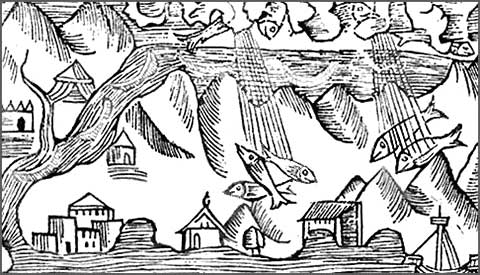Chapter 2
By Eugene F. Provenzo, Jr. and Cory A. Buxton
The Water Cycle

| Florida Sunshine State Standards Benchmark | |
| SC.B. 1.2.6 | The student knows ways that heat can move from one object to another. |
|---|---|
| SC.D. 1.2.3 | The student knows that the water cycle is influenced by temperature, pressure, and the topography of the land. |
| SC.H. 1.2.5 | The student knows that a model of something is different from the real thing, but can be used to learn something about the real thing. |
Modeling the Water Cycle

Clouds are mostly made up of water vapor.
Heating and cooling makes water change from one state to another. When we heat liquid water it evaporates into water vapor. Cooling the water vapor will cause it to change back into liquid water. The liquid water that falls back to Earth is called precipitation. This water cycle continues over and over.
Evaporation
Evaporation occurs when a liquid changes into a gas. The rate of evaporation is affected by heat - the hotter the liquid gets, the faster it evaporates. The more heat, the more evaporation. This is why it is so humid in hot climates near the ocean, such as Florida. There is a great deal of evaporation taking place.
Condensation
Condensation is the opposite of evaporation. Condensation occurs when a gas, such as water vapor, changes into a liquid, for example, the water we get from a tap. Water vapor is always present in the air. When the air is cool enough, the water vapor condenses and forms tiny drops of water.
Precipitation
As more and more droplets of liquid condense, such as water in clouds, the liquid droplets become bigger and heavier. Soon, they are so big and heavy that they can no longer stay suspended in the atmosphere. The drops fall back to Earth as rain.
A Cycle
A cycle is something that happens over and over again. The evaporation, condensation and precipitation of water in the atmosphere is an example of a cycle. You can observe the water cycle in action on a rainy day. You can also model the water cycle in your classroom or at home using the following simulations.
Simulation 1: Rain in a Pot
The following activity simulates how rain is created as part of a weather system.
Materials Needed:
- Water
- A stove or hot plate
- A clear glass pot
- A hot pad
- A copy of Water Cycle Simulation Activity Worksheet
To make your model of rain in a pot, follow the steps below:
- Pour 2 cups of water into a glass pot.
- Heat the water to boiling on a stove or hot plate.
- Carefully hold the glass lid 6–8 inches above the boiling water.
- Using the Water Cycle Simulation Worksheet, record your observations.
The water vapor from the boiling water is rising into the air. When the water vapor touches the cool glass lid, it condenses from a vapor back into a liquid. The water vapor, which is invisible, slowly becomes visible as small droplets of water. When the drops of water on a glass lid become large and heavy enough, they fall, like rain. This cycle repeats itself as long as the hot water keeps evaporating.
Have students review the following summary questions:
- Why do you think it rains more in some places than in others?
- Why do you think it often rains more in the summer than in the winter?
Simulation 2: Rain in a Plastic Cup
The following activity provides another simulation of how rain is created as part of a weather system.
Materials Needed:
- Three clear plastic cups
- Hot water
- Ice cubes
- Food coloring (preferably blue or green)
- Masking tape
- A copy of Water Cycle Simulation Activity Worksheet
To make your model of rain in a plastic up, follow the steps below:
- Place hot water in one plastic cup.
- Immediately cover this cup with another plastic cup turned upside down.
- Using masking tape, seal the two cups tightly.
- Place a few ice cubes in another cup on top of the middle cup.
- Put some food coloring in the cup with the ice cubes.
- Using the Water Cycle Simulation Activity Worksheet, record your observations.
Exploring One Water
How is climate change potentially affecting rain and water cycles? If the actions of people in one part of the world affects the livelihoods and existence of others, should those causing the change be held responsible? How should this be done?
It is believed that climate change will affect the poorest populations of the world most severely.
Consider the Quote
“Man is not an aquatic animal, but from the time we stand in youthful wonder beside a Spring brook till we sit in old age and watch the endless roll of the sea, we feel a strong kinship with the waters of this world.”
—Hal Borland (1900-1978), Sundial of the Seasons, 1964
Extension Activities
Elementary School Students
Students can learn about the basics of measurement by making a rain gauge and recording how much rain falls on a monthly basis where they live.
Materials Needed
- Scissors
- 1-quart empty clear plastic water bottle
- An old ruler
- Masking tape
Cut the plastic bottle at about 3⁄4 of its height from its base. Tape the ruler to the side of the bottle. Its bottom should line up with the base of the bottle. Place the rain collector in a safe open area that has no overhangs from buildings or trees nearby as this may interfere with the collection of rainwater. Keep a daily record of rainfall.
This activity can be extended over an entire school year. Students can compile the data they have collected into tables and graphs showing seasonal changes, and so on.
Multimedia: Rain Sticks
Rain sticks are traditional folk instruments that, according to legend, were first made by Chilean Indians to make rainy weather. When turned over, they sound like rain falling. Have students make their own rain sticks.
Materials Needed
- A paper towel tube or other long cardboard tube
- Aluminum foil
- Popcorn seeds or dry rice
- Scissors
- Masking tape
Cut two pieces of aluminum foil six inches wide and 3⁄4 as long as your tube. Scrunch the foil intot wo long pieces. Close up one end of the tube with tape and insert the pieces of foil into the tube .
Pour some rice or popcorn into the tube. You probably want to fill it about 1⁄10 of the way full. Tape the open end shut and gently turn the tube over. You should hear a sound like rain. Have students experiment with the sounds they can create. They can then create songs or dances using the rain sticks for sound effects or rhythm. Students can also record the sounds of the rain sticks and use them as the background for creating a sound poem about rain, or they can recite a poem they have created, shaking the rain stick and using its sound as part of their presentation
Middle School Students

A 1555 engraving of fish raining to the earth.
Ask students if they have ever heard the expression “raining cats and dogs.” Probably most students know that the phrase refers to the idea of it raining very hard. Actually there are numerous recorded instances of animals “raining” from the sky, as in the case of the 1555 French illustration on the right. Have students go online to discover whether or not animals raining from the sky is something that actually happens, and if it does, why? (Have them use the search term “raining animals”). Have each student compile a list with three examples of animals “raining” down and then ask them to write a short paragraph describing what happens in each of their examples. Finally, have them see if they can discover a meteorological explanation for why animals sometimes “rain” from the sky.
Multimedia
Using Power Point™, have students create a simple electronic children’s story that starts out: “Once upon a time, the animals rained from the sky.” This can be done as an individual activity or as a collective writing project. Encourage the use of illustrations and sound effects.
Secondary School Students
When precipitation (rain or snow) falls, it runs off and collects in a stream, river, or lake and may eventually flow to the ocean. All the land area that drains to a common body of water is called a watershed. Use the watershed website of the Environmental Protection Agency to locate the watershed where you live. Research the amount of precipitation that falls in your watershed each year and where it collects and flows
Multimedia
Create a poster showing your watershed. Include arrows that indicate the flow of water that has collected from precipitation. Highlight areas where this water may have become polluted during its journey.
